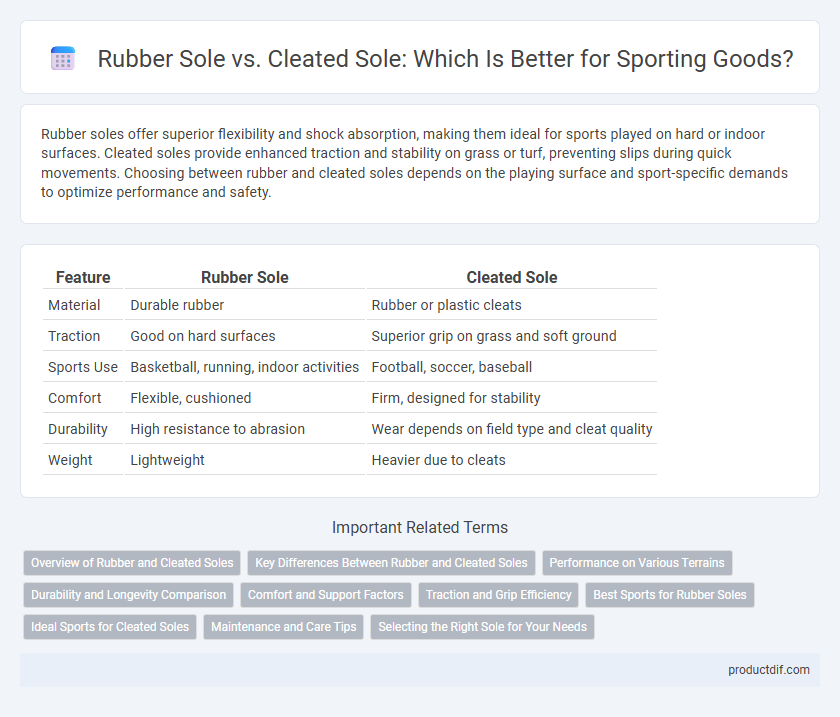Rubber soles offer superior flexibility and shock absorption, making them ideal for sports played on hard or indoor surfaces. Cleated soles provide enhanced traction and stability on grass or turf, preventing slips during quick movements. Choosing between rubber and cleated soles depends on the playing surface and sport-specific demands to optimize performance and safety.
Table of Comparison
| Feature | Rubber Sole | Cleated Sole |
|---|---|---|
| Material | Durable rubber | Rubber or plastic cleats |
| Traction | Good on hard surfaces | Superior grip on grass and soft ground |
| Sports Use | Basketball, running, indoor activities | Football, soccer, baseball |
| Comfort | Flexible, cushioned | Firm, designed for stability |
| Durability | High resistance to abrasion | Wear depends on field type and cleat quality |
| Weight | Lightweight | Heavier due to cleats |
Overview of Rubber and Cleated Soles
Rubber soles provide excellent traction and durability on hard surfaces, making them ideal for sports like basketball and running where grip on smooth courts is essential. Cleated soles feature protruding studs or spikes designed to dig into soft or uneven terrain, offering superior stability and traction in sports such as soccer, football, and baseball. Both types of soles are engineered to enhance athlete performance, with rubber soles emphasizing shock absorption and cleated soles maximizing grip on grass or turf fields.
Key Differences Between Rubber and Cleated Soles
Rubber soles offer superior flexibility and cushioning, making them ideal for general athletic activities on various surfaces, while cleated soles provide enhanced traction and grip specifically designed for turf or soft ground in sports like soccer and football. Rubber soles typically have a flat, smooth surface optimized for indoor use or hard courts, whereas cleated soles feature protruding studs or spikes that penetrate the ground to prevent slipping during rapid directional changes. The choice between rubber and cleated soles significantly impacts performance, injury risk, and sport-specific adaptability.
Performance on Various Terrains
Rubber soles excel on hard surfaces and indoor courts by providing superior grip and shock absorption, enhancing agility and reducing injury risk. Cleated soles are engineered for outdoor use, offering exceptional traction on grass, mud, and uneven terrains, improving stability and acceleration in sports like soccer and football. Choosing between rubber and cleated soles depends on the athlete's playing surface, as each sole type optimizes performance and durability in different environmental conditions.
Durability and Longevity Comparison
Rubber soles offer excellent durability through consistent wear resistance on hard surfaces, making them ideal for sports like running and tennis. Cleated soles, designed for traction on grass or turf, provide enhanced grip but are typically more prone to wear and tear from abrasive surfaces, reducing their overall lifespan. When comparing longevity, rubber soles generally outperform cleated soles in durability due to their solid, uniform construction and resistance to cracking or chunking.
Comfort and Support Factors
Rubber soles offer superior cushioning and flexibility, providing enhanced comfort for prolonged wear during casual sports activities. Cleated soles deliver excellent traction and stability on grass or turf surfaces, reducing the risk of slips while offering firm support for quick directional changes. Choosing between rubber and cleated soles depends on the specific sport and the balance needed between comfort and performance support.
Traction and Grip Efficiency
Rubber soles provide consistent traction on hard surfaces with flexibility that adapts to varied terrains, making them ideal for indoor sports and casual activities. Cleated soles feature protruding studs designed to dig into soft ground, offering superior grip and stability on turf, mud, and grass. The enhanced traction of cleated soles reduces slippage, improving performance in sports like soccer and football where sudden directional changes are frequent.
Best Sports for Rubber Soles
Rubber soles provide superior traction and flexibility on hard surfaces, making them ideal for sports like tennis, basketball, and indoor volleyball where quick lateral movements are essential. The shock absorption qualities of rubber soles reduce impact stress, enhancing performance in activities that demand constant running and jumping on gym floors. Their non-marking nature also preserves the quality of indoor courts, making rubber soled shoes the preferred choice for many indoor sports.
Ideal Sports for Cleated Soles
Cleated soles provide superior traction and stability on natural grass and soft, uneven surfaces, making them ideal for sports like soccer, football, and baseball. Their design penetrates the ground, reducing slippage and enhancing performance during quick directional changes and sprints. Athletes benefit from improved grip, which helps prevent injuries and maximizes agility in outdoor field sports.
Maintenance and Care Tips
Rubber soles require regular cleaning with mild soap and water to prevent dirt buildup and maintain flexibility, while avoiding exposure to extreme heat to prevent cracking. Cleated soles need thorough rinsing after use to remove mud and debris lodged between cleats, which can cause wear and reduced traction if neglected. Proper drying in a well-ventilated area and periodic inspection for damage extend the lifespan of both sole types, ensuring optimal performance on various sports surfaces.
Selecting the Right Sole for Your Needs
Choosing between rubber soles and cleated soles depends largely on the sport and playing surface. Rubber soles provide enhanced grip and durability on hard, indoor courts, making them ideal for sports like basketball and volleyball. Cleated soles offer superior traction on turf or grass, essential for outdoor sports such as soccer and football, where stability and quick directional changes are crucial.
Rubber Sole vs Cleated Sole Infographic

 productdif.com
productdif.com